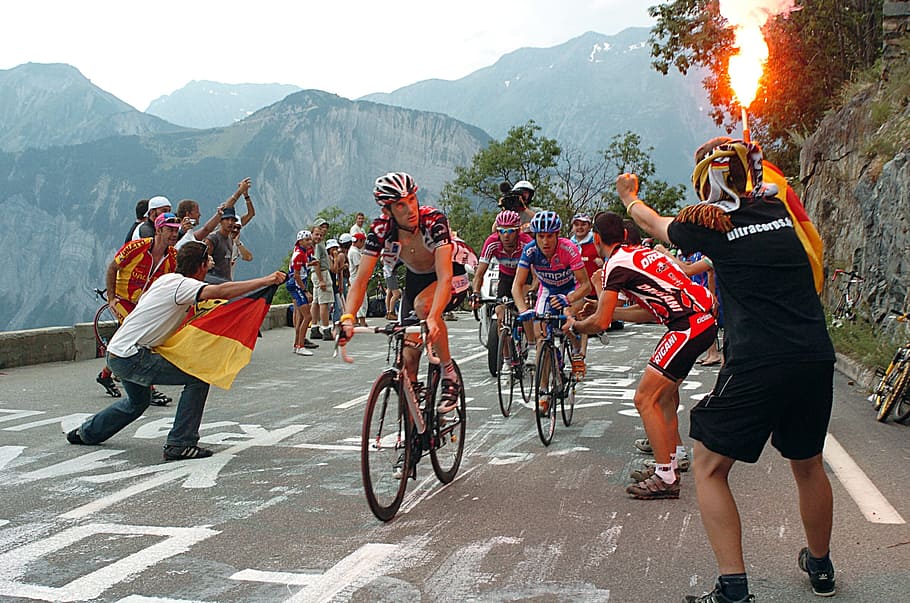After a brief period of sceptic uncertainty, it has been confirmed that the greatest test of human endurance and skilful determination in world cycling history, the grand Tour de France will go ahead for the year 2020.
The 107th edition of the historic racing feature will commence this week on August 29, and will see the world’s greatest cyclists go head to head in a 23 day long gruelling challenge to determine who will wear the prestigious Maillot Jaune (the Yellow jersey) on the top step of the podium in front of the grand Champs-Élysées in Paris.
For a complete beginner the Tour, as its most commonly referred, may all seem a little overwhelming at first, with complex stage names and confusing strategy calls from riders all wearing brightly coloured jerseys brimming with sponsors, one might not know where to look!
Never fear, here are few simple things that you will need to know before you intend to experience and enjoy the greatest cycling feature ever known to humankind.
What is Le Tour de France and what’s its significance?
The Tour was founded in 1903 by Henri Desgrange, editor of L’Auto newspaper as a method of promoting his publication. Back in the day advertising a product wasn’t as easy as putting an ad on the radio or in a newspaper. Especially in rural parts of France where much of its small village industries were closed off to outsiders. Therefore, as a way of spreading his publications reach and popularity to the most rural regions in France, Desgrange decided to hold a bicycle race that would be held in France and go through all these small towns and villages as a way of promoting the sport and his newspaper. Over the past 107 occasions of the Tour the race has managed to capture the imagination of the public and thus become the biggest annual sporting event in the world with more live spectators than even the Olympic Games or the FIFA World Cup!
Le Tour Explained
The Tour de France is primarily a stage race that is broken down into 21 stages. Why the Tour is a show of great physical human skill is because on average, participants will cycle over 175km in a day consecutively for 23 days with only two rest days in between!
This year the Peloton, the main group of cyclists, will set off from Nice where two stages will be held in the dreamy coastal city. The riders however won’t have time to admire their amicable surroundings as the winner of the Tour is determined by the rider with the lowest cumulative finishing times in each stage.

One can easily identify the leader the Tour by the striking yellow jersey with the words ‘LCL’ on the front that they will don for the duration of the race.
While the Maillot Jaune is the most celebrated jersey in the race, there are other jerseys up for grabs in what is known as Classifications.
The Yellow jersey is what is worn by the leader of the General Classification. It is mandatory that each team consist of nine riders. They resolve to strategy and team work to ensure that their Lead Rider is dominating in that class and finishing ahead of other riders.

Then there is the Maillot Vert (Green jersey), awarded to the rider according to the position that they finish each stage. The winners in each of the 21 stages will be awarded the highest points with less points awarded to those that cross in second, third, etc. Some stages such as a Sprint stage will carry a higher point score in comparison with a Time-trial stage. The points are then tallied up after each stage and added to points won in all previous stages.
Next is the most interesting looking jersey awarded to the King of the Mountains Classification winner. This is a very distinct white jersey with red polka dots and therefore, it is referred to as the Maillot à Pois Rouges (the Polka-dot jersey). The winner of this classification is determined by points awarded to the riders who crest the numerous Le Tour climbs first. Points awarded depends on the severity or category of the mountain determined by the organisers.
Finally, there is the classification for the pelotons Best Young Rider. It’s the least distinctive of all of the classification jerseys as it is plain white. However, winning the jersey is no easy task as it is awarded to the under-26 rider who has completed the Tour de France in the least amount of time. Egan Bernal at the age of 22 became the youngest rider in the past 110 years to win this classification and is the bookmaker’s favourite to win this year’s race.

Sylvian Chavanel climbs the mountains in the Polka dot jersey
Who are the Favourites?
These will be the riders most favoured to win and it will be their names that are thrown around by commentators and cycling fans globally during the race:
Egan Bernal, Colombia (Team Ineos Grenadiers)
Primoz Roglic, Slovenia (Team Jumbo-Visma)
Chris Froome, Great Britain (Team Ineos Grenadiers)
Thibaut Pinot, France (Team Groupama-FDJ)
Geraint Thomas, Great Britain (Team Ineos Grenadiers)
Tom Dumoulin, Holland (Team Jumbo-Visma)
Nairo Quintana, Colombia (Team Arkéa-Samsic)
Tadej Pogacar, Slovenia (UAE Team Emirates)
Julian Alaphilippe, France (Team Deceuninck-Quick Step)
Adam Yates, Great Britain (Team Mitchelton-Scott)
Emanuel Buchmann, Germany (Team Bora-Hansgrohe)
Miguel Ángel López, Colombia (Team Astana)
Mikel Landa, Spain (Team Bahrain-McLaren)
Steven Kruijswijk, Holland (Team Jumbo-Visma)
Richie Porte, Australian (Team Trek-Segafredo)
Enric Mas, Spain (Team Movistar)
Jakob Fuglsang, Denmark (Team Astana)
Romain Bardet, France (Team Ag2r-La Mondiale)
Fabio Aru, Italy (UAE Team Emirates)
Rigoberto Urán, Colombia (Team EF Education First)
The Top Teams
- Team Ineos Grenadiers
- Team Jumbo-Visma
- Team Bora-Hansgrohe
- Team Movistar
- Team Astana
- UAE Team Emirates
- Team Bahrain-McLaren
- Team Arkéa-Samsic
- Team Mitchelton-Scott
By Randev Jayasinha

